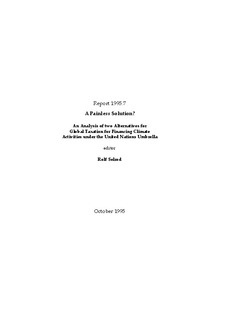| dc.description.abstract | It is a widely held perception that the UN is unable to challenge the increasing number of global issues due to the lack of funding. Consequently, there has for some time, been a discussion of alternative ways of financing UN activities. This is also the case for activities under the UN Framework Convention on Climate Change.
The level of global efforts to reduce greenhouse gas emissions is lower than the declared willingness of many countries to invest in such actions. Given this point of departure, one must anticipate that time is ripe to search for mechanisms that may close this mismatch.
We believe that such funding schemes must relate to specific international agreed needs, not distort market conditions, and reflect a fair burden-sharing between countries. If the system also may be close to “painless” for individuals, industry and countries, that is, if the charge is regarded as a fair payment for the service rendered, we may have an interesting proposal at our hand.
The report mention some global financing schemes discussed over the last years. Most of these earlier suggestions for automatic financing schemes have not possessed the above mentioned characteristics, and thus failed to meet universal support.
We focus, however, on two alternatives for “automatic” financing, as possible sources and systems of funding. The funds will be for the benefit of developing countries and countries that are undergoing the process of transition to a market economy, to fight global environmental problems, specifically in the area of climate change.
One of these, an international charge on civil aviation will, in addition to its revenues, also contribute directly to reduce greenhouse gas emissions. It will initially, albeit in a small scale, reduce demands for air traffic and may, dependent upon the chosen base for taxation, also contribute to development of better energy saving technologies etc. The other alternative, an internationally agreed tax on foreign currency transactions, may in addition to its revenues also discourage currency speculation. This alternative has been discussed as a possible source of funding in a more general financing context within the United Nations system.
This report concludes that a small charge on aviation seems to meet most of the criteria mentioned above for a possible successful mechanism for financing UN activities in the area of climate change. It seems right in a “polluter pays” context, in a north-south context, and as a practical, fair and almost painless solution with small side-effects. It seems also to be relatively easy to collect and control. The tax base may be related to the number of passengers, the number of passenger kilometre, the number of flights or as a fuel tax. This issue as well as the level of the tax may be agreed through negotiations between countries, Parties to the Climate Convention, or through other chosen international organisations. What seems most challenging is to initiate protocol negotiations under the Climate Convention, were an agreement would have to be ratified by the governments to create legally binding commitments.
To establish a fund with an illustrative figure of 10 billion USD revenue per year, one would need about 9 USD as an average charge per passenger (departure tax), or about 0.5 US cent per passenger kilometre, or a tax on an average flight of about 650 USD. Both a fuel tax and a tax on passenger-kilometres might be preferred as it is close to taxing emissions of carbon dioxide. However, as a fuel tax will discriminate those countries and companies with older and less energy-efficient air-planes, one might concentrate on the passenger related charge, either passenger/kilometres tax or a passenger/departure tax. The latter may be preferred for environmental reasons, as short journeys are more polluting because of the high energy intensity of the start and landing phases. A combined solution may be considered, for instance to charge according to standard intervals of flight distance of 380 kilometres.
Several studies on a possible international tax on foreign currency transactions have voiced considerable scepticism. This scepticism is shared by the authors of this report for several reasons. First, a currency tax will only to a limited extent curb speculation. Secondly, there are significant legal and administrative problems when introducing a global transaction tax, and the effectiveness of the tax would be greatly reduced if some governments decided against it. Finally, it is reasonable to assume that financial innovations and use of vehicle currencies would make tax evasion easy. Due to these weaknesses, we conclude that other funding alternatives might be more attractive to pursue. | nb_NO |
